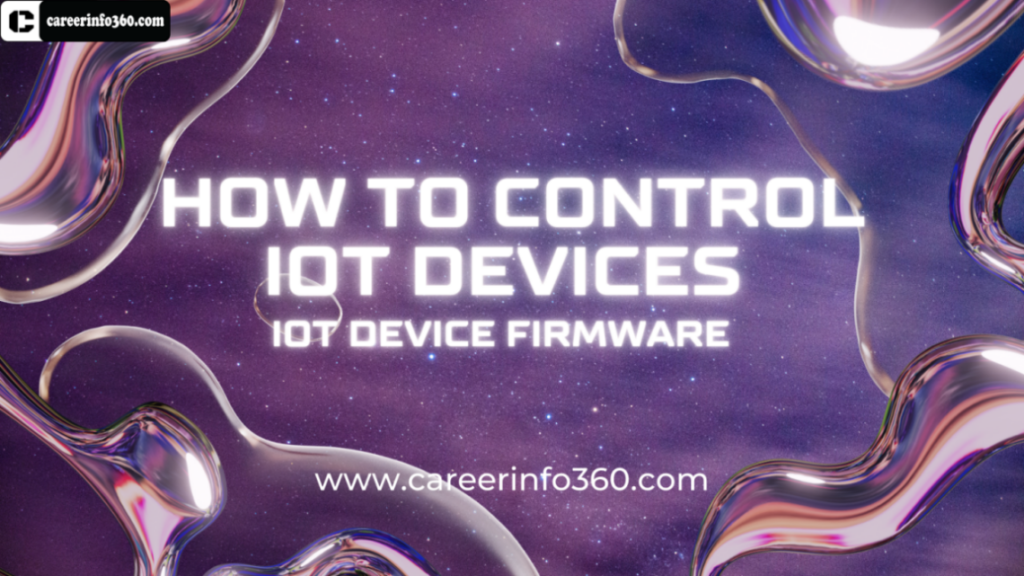How to Control IoT Devices:
The Internet of Things (IoT) is already firmly entrenched in modern society as in today’s world knows or not How to Control IoT Devices. However, how can you command over all of your IoT devices and not have an anxiety attack? Let’s dive in!
1. Centralize Your Control: Purchase a smart home hub (e.g., Amazon Echo or Google Home) for managing devices under one roof.
2. Mobile Apps: Get specific apps from the manufacturers for ultimate control. These tools have been straightforward and provide a platform for device-specific capabilities.

3. Voice Commands: Command with your voice and work hands-free. To start using Cortana, just say “Hey Alexa” or OK Google.
4. Automate Tasks: Create set times for IoT devices to function asynchronously.
5. Network Security: Use a protected Wi-Fi connection, keep your phone and tablet updated with the latest firmware updates, and never click on suspicious links when connected to public Wi-Fi networks.
IoT Device Monitoring:
Nowadays in the technology era, IoT has changed the way we live at home and do business. But running them efficiently is important.
Why IoT Device Monitoring Matters:
Picture yourself no longer having to fret over your smart thermostat freezing up during a heatwave, or your alarm system going down. IoT device monitoring empowers you to:
1. Real-Time Insights: Monitor device status & performance round-the-clock.
2. Proactive Issue Resolution: Determine issues before the issue emerges in your Life.
3. Remote Management: Remotely configure settings, troubleshoot, or turn devices on/off.
- Data Security: Protect user private information from compromise through anomaly detection.
5. Energy Efficiency: Reduce energy bills by optimizing usage patterns.
Through IoT device monitoring you are in charge. Keep device glitches from spoiling your day. Embrace this digitally savvy answer and benefit from an effortless associated way of life.
Do IoT Devices have Firewalls:
Our connected world means we’re surrounded by IoT (Internet of Things) gadgets that are changing the way we live. However, do they come with firewalls? Well, it varies.
Some high-end IoT devices, particularly those used in demanding environments such as industrial or critical systems, already have internal firewalls. Consumer-grade devices may be prone to being inexpensive and lacking strong security features. However, feel free—if there is no firewall in your device, you can do it via third-party apps, or better yet, protect your network itself.
To summarize we can say firewalls in IoT devices are not consistent. Security should be considered when choosing and reinforced if necessary. It’s up to you to keep yourself safe online. Stay Safe and Keep Connected! with the Internet of Things (IoT) Era.

IoT Device Firmware:
Living in an ever-changing world of IoT, there’s no shortage of trendy items one can get enticed with. But how do those wonders at it work? And meet IoT device firmware—your best friend in the world.
Decoding IoT Device Firmware:
The device’s central nervous system is the IoT device firmware—you just don’t know it. Here’s the scoop:
1. Continuous Upgrades: Updates to firmware add new features, security patches, and bug fixes to keep devices safe and current.
- Security: Outdated firmware invites cyber risks. Updates act as a cloak of protection.
3. Better Performance: Firmware updates improve device performance, ease of use & function to deliver the best end-user experience possible.
4. Compatibility: This would often update the software to fix compatibility issues with other devices and to make things just work.
IoT Device Management Features:
We live in an era where the IoT is king, where things have become easier because of Technology. Knowing important IoT device management features is necessary.
Essential IoT Device Management:
1. Remote Control: Convenient and accessible, manage your devices no matter where you are.
2. Security: Ensure robust security measures for your IoT network & data protection.
3. Firmware Updates: Make sure devices are up-to-date for peak performance and security.
4. Authorization: Check the identity of the hardware to prevent unauthorized access.
5. Scalability: Manage even larger networks of your growing IoT network with ease.
6. Data Insights: Use data to make better decisions and offer the best UX possible.
7. Customization: Configure according to your requirements and manage devices efficiently.
With IoT device management, you can control every aspect of your connected digital lifestyle with ease. Accept it, secure your devices, and leverage true IoT technology.
IoT Device Remote Reboot:
Convenience is king in the big, wide world of IoT to control How to Control IoT Devices. An important aspect of managing IoT devices is having the ability to remotely reboot a device. It enables an online reset of your IoT devices. Using remote reboot means you’re saving time and energy. You don’t need to have physical device access anymore; just click a button or two on the screen of your computer or phone to reboot. This is the perfect solution for small bugs and connectivity problems, helping to prevent downtime.With remote reboots, you get smooth operations even when working professionally. It enables a non-stop smart home experience and entertainment for home users.
The bottom line therefore, a remote reboot of an IoT device is very advantageous to us and we have a better IOT experience with it. Your passport to a linked and frustration-free one. Say goodbye to device frustrations!
IoT Device Update:
Let’s Unveil the Significance of IoT Device Updates:
1. Enhanced Security: Often updates contain important security fixes protecting your machines from possible exploits.
2. Improved Features: Because updates bring you new features and innovations — the cutting edge of what technology can do today.
3. Stability: You can fix bugs and glitches with updates — meaning your IoT devices will be more stable and dependable.
- Compatibility: Keeping your IoT devices up-to-date ensures the smoothest integration’s with other devices and platforms.
5. Longevity: Updates help prolong the life of the device ensuring cost savings even over time.
To summarize, updates for IoT devices are crucial to keep your Smart Devices working efficiently and securely. Welcome these updates for yourself, and embrace them to keep up with trends in technology and to benefit from increased safety, and more efficient IoT. And your devices would surely appreciate it.
Learn Ai and its feature must visit



Good post. I learn something totally new and challenging on blogs
I stumbleupon everyday. It’s always useful to read through articles from other authors
and use something from their websites.